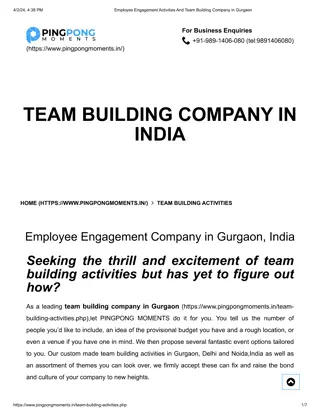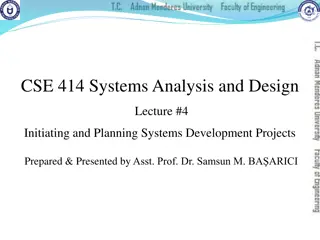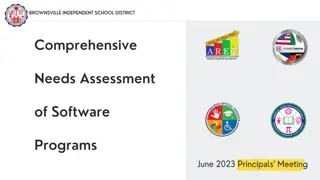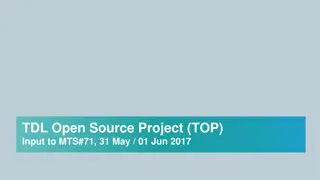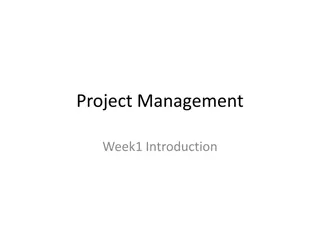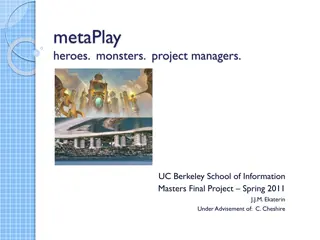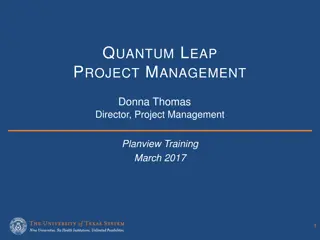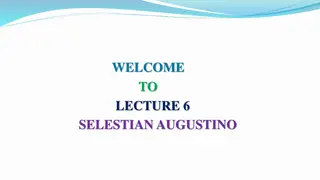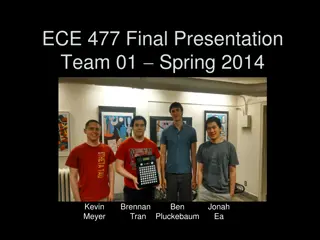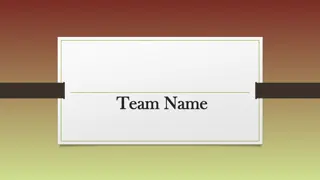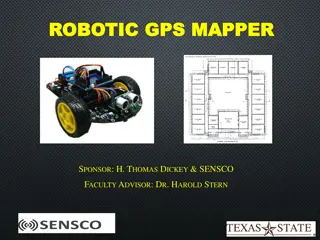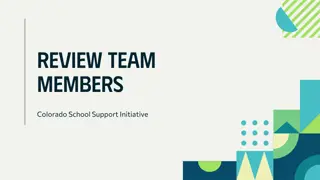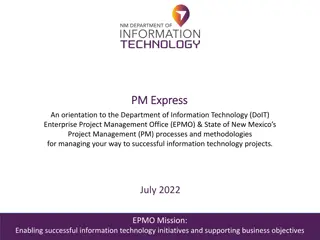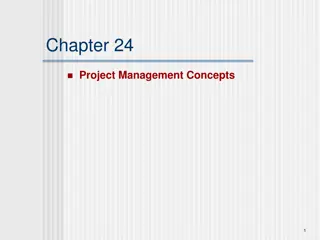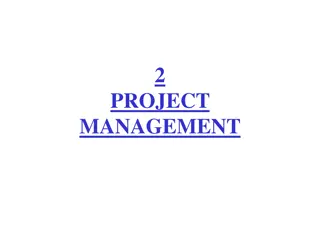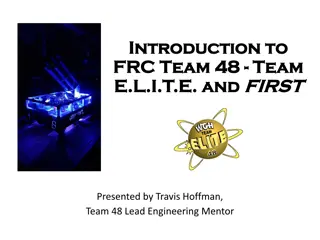Team Development and Project Management
Explore the dynamics of team development, building trust, managing conflict, and embracing accountability in software project management. Dive into Tuckman's Model for Team Development and understand the importance of team structure and skills in achieving project success.
Download Presentation

Please find below an Image/Link to download the presentation.
The content on the website is provided AS IS for your information and personal use only. It may not be sold, licensed, or shared on other websites without obtaining consent from the author.If you encounter any issues during the download, it is possible that the publisher has removed the file from their server.
You are allowed to download the files provided on this website for personal or commercial use, subject to the condition that they are used lawfully. All files are the property of their respective owners.
The content on the website is provided AS IS for your information and personal use only. It may not be sold, licensed, or shared on other websites without obtaining consent from the author.
E N D
Presentation Transcript
Team SE423: Software Project Management 1
Outline Team Development Building Trust Managing Conflict Embracing Accountability Team Models Managing People 2
Team Development - Introduction What are your responsibilities as a team member? As a Project Manager? How does Team Development relate to the Project Triangle? What s more important? The strength of individual team members, or the strength of the team? What are some characteristics of a good team? 4
Quote Software projects fail for one of two general reasons: the project team lacks the knowledge to conduct a software project successfully, or the project team lacks the resolve to conduct a project effectively. - Steve C McConnell 5
Team Skills, Influence, and Style Skills Types of Influence Leadership Styles 6
Needs and the Team Lower level needs must be satisfied before higher level needs can be addressed 7
Tuckman's Model for Team Development 1. Forming: The group comes together and gets to initially know one another and form as a group. 2. Storming: A chaotic vying for leadership and trials of group processes 3. Norming: Eventually agreement is reached on how the group operates 4. Performing: The group practices its craft and becomes effective in meeting its objectives 5. Dissolving/Adjourning 8
Team Structure What s the team s objective? Problem resolution Complex, poorly-defined problem Focuses on 1-3 specific issues Ex: fixing a showstopper defect Sense of urgency Creativity New product development Tactical execution Carrying-out well-defined plan Focused tasks and clear roles 9
Building Trust Trust is the foundation of teamwork Trust is all about vulnerability, which is difficult for most people. Takes time. Needs to be maintained over time. Techniques Behavioral profiling (like MyersBriggs). Helps to admit strengths & weaknesses. 11
Establishing a basis of trust A solid basis for trust is earned, not granted Most human beings in most situations are inherently wary of others Maintain open communication within the project team communication barriers create project risks Be fallible. Take responsibility for making mistakes, correct them, and make it clear how you plan to avoid these mistakes in the future Lead by example rather than by mandate. Show the team what you expect from yourself and from them Complete all your commitments on time. If you cannot do so, give adequate notice and an explanation, not an excuse Don t confuse friendship with leadership 12
Managing Conflict Good conflict among team members requires trust, which is all about engaging in unfiltered, passionate debate around issues. Even among the best teams, conflict will at times be uncomfortable. Conflict norms will vary in each team, and must be discussed and made clear. The fear of occasional personal conflict should not deter a team from having regular, productive debate. 14
Managing Conflict How? Conflict Resolution Techniques Confronting (Problem Solving) Compromising Withdrawal (Avoidance) Smoothing (Accommodating) Collaborating Forcing Problem Solving 1. Define the real/root problem 2. Analyze the problem 3. Identify Solutions 4. Pick a Solution 5. Implement a solution 6. Review the solution, and confirm that it solved the problem 15
Managing and resolving conflict Every team encounters conflict successful teams resolve conflicts, while unsuccessful teams force conflict to the background Disagreement is not the same as conflict conflict involves a hardening of position and associated intractability Virtually all conflict can be traced to a clash between two parties To preserve a team s effectiveness, those outside the conflict must assume a neutral stance, even if they themselves agree with one of the parties to the conflict One of those outside the conflict must take on the role of conciliator; he or she must mediate between the two parties to defuse the situation The goal is to reduce the conflict to a disagreement which can then be addressed through consensus Strive for reconciliation between the conflicting parties, if possible 16
Achieving Commitment Commitment requires clarity & buy-in Clarity requires that teams avoid assumptions and ambiguity, and end discussions with a clear understanding about what they ve decided upon. Buy-in does not requires consensus. Members of great teams learn to disagree with one another and still commit to a decision. 17
Embracing Accountability Accountability on a strong team occurs directly among peers. For a culture of accountability to thrive, a leader must demonstrate a willingness to confront accountability. Best opportunity occurs during meetings and regular review of accomplishments. 19
Embracing Accountability RACI Responsible, Accountable, (Support), Consulted, Informed 20
Responsibility Assignment Matrix A resource planning tool Who does What Can be for both planning and tracking Identify authority, accountability, responsibility Who: can be individual, team or department Can have totals/summary at end of row or column (ex: total Contributors on a task) 21
Simple RAM 22
Skills Matrix Another resource planning tool Resources on one axis, skills on other Skills can be high level or very specific Cells can be X s or numeric (ex: level, # yrs.) 23
Focusing on Results The true measure of a great team is that it accomplishes the results it sets out to achieve. To avoid distractions, team members must prioritize the results of the team over their individual or organizational (dept) needs. To stay focused, team must publicly clarify their desired results and keep them visible. 24
Team Models 25
Team Models Two early philosophies Decentralized/democratic Centralized/autocratic Variation Controlled Decentralized 26
Team Models Business Team Most common model Technical lead + team (rest of team at equal status) Hierarchical with one principal contact Can be strong or loose hierarchy Adaptable and general Variation: Democratic Team All decisions made by whole team See Weinberg s egoless programming model 27
Democratic team organization The group acts as a whole and comes to a consensus on decisions affecting the system The group leader serves as the external interface of the group but does not allocate specific work items Rather, work is discussed by the group as a whole and tasks are allocated according to ability and experience This approach is successful for groups where all members are experienced and competent Sometimes known as self-organizing teams. 28
Agile programming groups Agile programming groups are variants of democratic organization In Agile programming groups, some management decisions are devolved to group members In XP, Programmers work in pairs and take a collective responsibility for code that is developed 29
Team Models Chief-Programmer Team a.k.a. surgical team From IBM in 70 s See Brooks and Mythical Man-Month Puts a superstar at the top Others then specialize around him/her Backup Programmer Co-pilot or alter-ego Administrator Tool-smith Language lawyer Issues Difficult to achieve Ego issues: superstar and/or team Can be appropriate for creative projects or tactical execution 30
Chief programmer teams Consist of a kernel of specialists helped by others added to the project as required The motivation behind their development is the wide difference in ability in different programmers Chief programmer teams provide a supporting environment for very able programmers to be responsible for most of the system development 31
Problems This chief programmer approach, in different forms, has undoubtedly been successful However, it suffers from a number of problems Talented designers and programmers are hard to find. Without exceptional people in these roles, the approach will fail Other group members may resent the chief programmer taking the credit for success so may deliberately undermine his/her role High project risk as the project will fail if both the chief and deputy programmer are unavailable Organizational structures and grades may be unable to accommodate this type of group 32
Team Models Skunk works Team Put a bunch of talented, creative developers away from the mother ship Off-site literally or figuratively Pro: Creates high ownership & buy-in Con: Little visibility into team progress Applicable: exploratory projects needing creativity Not on well-defined or narrow problem SWAT Team Highly skilled team Skills tightly match goal Members often work together Ex: security swat team, Oracle performance team 33
Team Models Large teams Communication increases multiplicatively Square of the number of people 50 programmers = 1200 possible paths Communication must be formalized Always use a hierarchy Reduce units to optimal team sizes Always less than 10 (seven plus or minus one) What is the optimal team size? 4-6 developers Tech lead + developers Small projects inspire stronger identification Increases cohesiveness QA, ops, and design on top of this 34
People in the process People are an organization s most important assets The tasks of a manager are essentially people oriented. Unless there is some understanding of people, management will be unsuccessful 36
Management activities Problem solving (using available people) Motivating (people who work on a project) Planning (what people are going to do) Estimating (how fast people will work) Controlling (people's activities) Organizing (the way in which people work) 37
Motivation An important role of a manager is to motivate the people working on a project Motivation is a complex issue but it appears that there are different types of motivation based on Basic needs (e.g. food, sleep, etc.) Personal needs (e.g. respect, self-esteem) Social needs (e.g. to be accepted as part of a group) Maslow s hierarchy of needs 38
Motivating people Motivations depend on satisfying needs It can be assumed that physiological and safety needs are satisfied Social, esteem and self-realization (self-actualization) needs are most significant from a managerial viewpoint If a lower set of needs is continually unmet for an extended period of time, the individual will temporarily re-prioritize those needs dropping down to that level until those lower needs are reasonably satisfied again. 40
Need satisfaction Social Provide communal facilities Allow informal communications [See Weinberg s story about the Coke machine.] Esteem Recognition of achievements Appropriate rewards Self-realization Training people want to learn more Responsibility 41
Personality types The needs hierarchy is almost certainly an over-simplification Motivation should also take into account different personality types: Task-oriented The motivation for doing the work is the work itself Self-oriented The work is a means to an end which is the achievement of individual goals e.g. to get rich, to play tennis, to travel etc. Interaction-oriented The principal motivation is the presence and actions of co-workers. People go to work because they like to go to work 42
Motivation balance Individual motivations are made up of elements of each class Balance can change depending on personal circumstances and external events However, people are not just motivated by personal factors but also by being part of a group and culture. People go to work because they are motivated by the people that they work with 43
Group working Most software engineering is a group activity The development schedule for most non-trivial software projects is such that they cannot be completed by one person working alone Group interaction is a key determinant of group performance Flexibility in group composition is limited Managers must do the best they can with available people 44
Time distribution 20% Non-productive activities 50% Interaction with other people 30% Working alone 45
Group composition Group composed of members who share the same motivation can be problematic: Task-oriented everyone wants to do their own thing Self-oriented everyone wants to be the boss Interaction-oriented too much chatting, not enough work An effective group has a balance of all types Can be difficult to achieve because most engineers are task-oriented Need for all members to be involved in decisions that affect the group 46
Group leadership Leadership depends on respect not titular status (titular = holding a title) There may be both a technical and an administrative leader Democratic leadership is more effective than autocratic leadership A career path based on technical competence should be supported 47
Group cohesiveness In a cohesive group, members consider the group to be more important than any individual in it Advantages of a cohesive group are: Group quality standards can be developed Group members work closely together so inhibitions caused by ignorance are reduced Team members learn from each other and get to know each other s work Egoless programming where members strive to improve each other s programs can be practiced 48
Developing cohesiveness Cohesiveness is influenced by factors such as the organizational culture and the personalities in the group Cohesiveness can be encouraged through Social events, such as team outings Developing a group identity and territory Explicit team-building activities Openness with information is a simple way of ensuring all group members feel part of the group 49
Group loyalties Group members tend to be loyal to cohesive groups 'Groupthink' is preservation of group irrespective of technical or organizational considerations Management should act positively to avoid groupthink by forcing external involvement with each group 50


